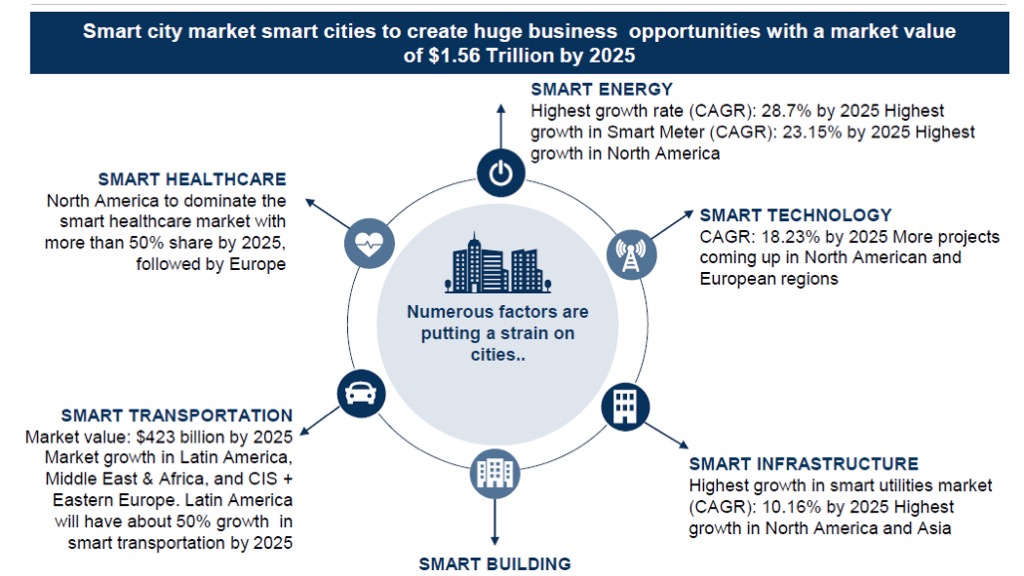The Positive Outlook of Smart Cities around the World by 2025
According to the report by Frost and Sullivan, the Smart City Market is expected to reach a market size of US$1.65 trillion by 2025. A smart city is made up of 8 functional pillars that strive to enhance operational efficiency and bring a better standard of living for its community. The 8 pillars are energy, building, mobility, technology, infrastructure, healthcare, governance, and citizens.
Some of the popular funding mechanisms for smart city plans in Europe are the use of special development funds, partnerships, and private investments. In the future, these funding mechanisms are also expected to be more popular across the globe.
With smart cities reported to generate $20 trillion in economic benefits by 2026 according to a report by Barclays, these key functional pillars will play a pivotal role in smart cities' plan and will likely see greater funding. These are some of the key areas in that we will likely see exponential growth in the ASEAN region, driven in part due to COVID and greater pressure to reduce global emissions.

- Smart Technology. COVID-19 has led to a fundamental change in work culture, with remote working expediting the need for reliable and secure high-speed connectivity. Last year, we also saw record M&A funding with technology companies taking the lion’s share. The accelerated growth of 5G, AI, VR, MR,AR, and blockchain will continue to drive the evolution of smart cities. We have already seen how the blockchain-based game Axie Infinity has been a source of income for the majority of the Philippines population. Blockchain-based technology can help to expedite processes such as payment transfers. Stellar lumen is another blockchain-based solution that is increasingly being used for emerging economies that heavily rely on remittances for economic growth. Advanced computing, zero-knowledge proofs, and secure multi-party computing will also help to drive consumer protection as we become more interconnected in the world wide web. Fintech also improves the operational efficiency of firms. With the increasing adoption of AI, institutions gain operational efficiency via the automation of manual tasks and the replacement of human decisions with advanced diagnostics. The demand for IoT is also increasing, bringing greater efficiency and convenience for businesses and consumers.
- Smart Building + smart energy. With ESG taking the center stage in 2021 driving greater awareness of the importance of preserving and protecting our environment, funding and investments in this area have seen notable increases. The global smart energy market was valued at $124 billion in 2019 and is expected to grow at a CAGR of 9.6% from 2020 to 2027 and reach a market cap of $253.1 billion in 2027. Based on a report by Barclay, commercial buildings take up 20% of energy use in the US, 30% of which is lost. Buildings are expected to be net-zero by 2050 to meet the requirements of the Paris Agreement. Smart energy initiatives and solutions will be the key in reducing our carbon footprint if we are to make the world a more sustainable place for future generations. In addition, with work from home being the norm, the smart energy market is here to stay. China, India, Japan, and Korea are key players that will bring the market value to $1 trillion by 2030.
- Smart healthcare. We witnessed how COVID-19 has led to a strain in physical healthcare infrastructure and services. These led to longer waiting times, operational inefficiency, and a strain on resources. Smart healthcare solutions aim to fill up this gap and inefficiency by deploying IoT services to better provide treatments at improved costs. North America is expected to be the largest market player in the industry by 2025 followed by Europe. A smart city is more than just having digital infrastructures. It is the responsible use of technological infrastructures to improve the quality of life and address urban challenges facing society.
- Smart transport The smart transportation market size is expected to grow to USD 285.12 billion by 2030, growing at a CAGR of 12.6% from 2022 to 2030.Smart transportation technologies offer specific data such as real-time arrival information to consumers to reduce the waiting time. They also inform users of the capacity of the transport mode. Aside from reducing the waiting time of passengers, a greener environmental footprint is also expected to drive the growth of the market in line with governments calling for the need to reduce carbon emissions.

